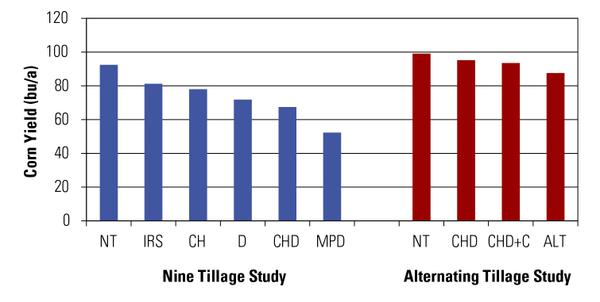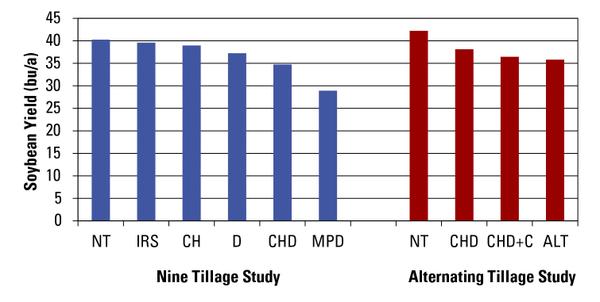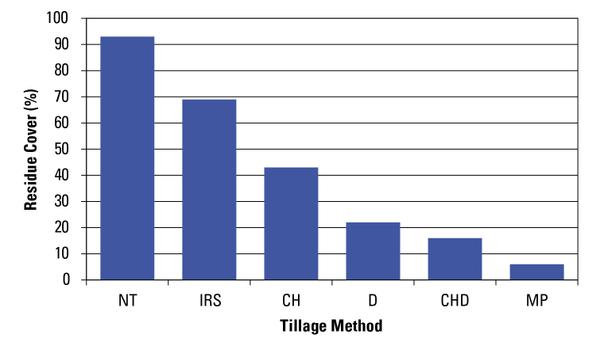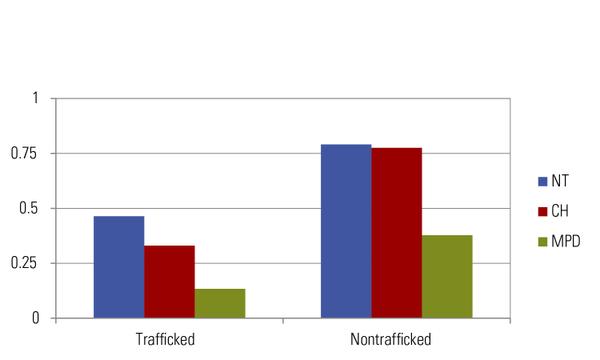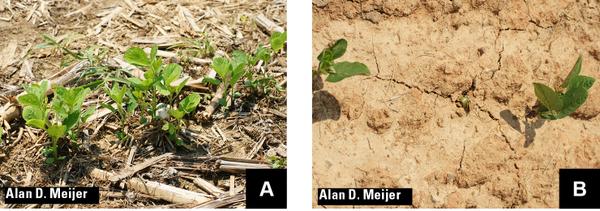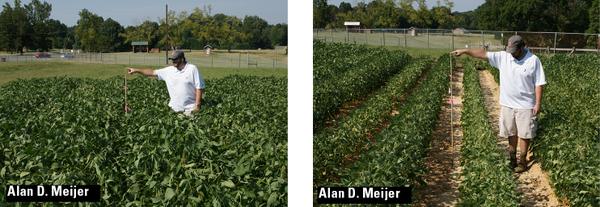The profitability of a cropping system can be influenced by tillage effects on crop growth and yield. Additionally, machinery costs and fuel consumption are dependent on the tillage method used. Choosing the best tillage system is important for operating a productive, sustainable farm. Tillage research in North Carolina strongly suggests that on well-drained soils, no-tillage (or tillage with minimal soil disturbance) is most productive for large-seeded crops like corn and soybean. Corn and soybean yield data from two long-term tillage trials in North Carolina’s Piedmont confirm how reducing tillage improves yield.
The Reidsville Tillage Tests
In the early 1980s, two tillage experiments were initiated at the Upper Piedmont Research Station in Reidsville, North Carolina, by soil scientists Paul Denton and Michael Wagger. Soils at the experimental sites are a Casville (formerly Wedowee and Pacolet) sandy loam, typical of soils throughout much of the Piedmont. The Nine Tillage Study was designed to compare nine different tillage methods that vary in intensity and timing. The Alternating Tillage Study was implemented to evaluate the effects of alternating no-till with conventional tillage. The tillage treatments used in the two experiments are outlined in Table 1 below.
| Tillage Treatment | Abbreviation |
|---|---|
| Nine Tillage Study | |
| No-till | NT |
| No-till with in-row subsoiling | IRS |
| Spring disk | D |
| Chisel plow* | CH |
| Chisel plow with disk* | CHD |
| Moldboard plow with disk* | MPD |
| Alternating Tillage Study | |
| Alternating CHD and NT annually | ALT |
| Chisel plow with disk, plus cultivation for weed control | CHD+C |
| Chisel plow with disk | CHD |
| No-till | NT |
| * Chisel and moldboard plow treatments were performed in spring and fall, thus making up the full complement of nine tillage systems. However, timing has shown no effect on yield, so results from the spring and fall treatments were combined to create an average value. | |
These two studies, having been maintained continuously for over 25 years in a corn-soybean rotation (corn replaced soybeans twice over that span), afford us the opportunity to examine the long-term effects of tillage practices on crop yield, crop residue ground cover, and infiltration. Long-term crop yields in these two experiments are comparable to average nonirrigated, upland yields of the Piedmont.
Corn Yield
No-till produced the highest average corn yield in both experiments (Figure 1), yielding best in nine of 14 years in the Nine Tillage Study and seven of 13 years in the Alternating Tillage Study. The highest corn yield in a single year (no-till, 2006) was 163 bu/a in the Nine Tillage Study and 162 bu/a in the Alternating Tillage Study (no-till, 2006). In some years, when drought-like conditions existed, average corn yields over the entire experiment were as low as 21 bu/a in the Nine Tillage Study and 53 bu/a in the Alternating Tillage Study. There were also large year-to-year differences in the range of yields found among the treatments. For example, no-till outyielded moldboard plow plus disk by 80 bu/a in 1989, while the narrowest range occurred in 1995 when only 13 bu/a separated all treatments in the Nine Tillage Study. These variations were most likely due to rainfall in a given season. When rainfall is plentiful, tillage methods may not affect corn yield, as all plants have enough water. The same can be true for extremely dry years where no plant has adequate water. Either extreme can serve as an equalizer.
Soybean Yield
Similar to corn yields, the no-till treatment produced the highest average soybean yield in both experiments (Figure 2), yielding best in three of eight years in the Nine Tillage Study and five of eight years in the Alternating Tillage Study. The highest yield for any treatment over the course of the experiment was 62 bu/a in the Nine Tillage Study (fall chisel, 2000) and 65 bu/a in the Alternating Tillage Study (no-till, 1992). In two years (1998, 2002), crop failure associated with insufficient rainfall resulted in no harvest data. The range of yields varied from year to year as well, with the highest- and lowest-yielding tillage treatments being separated by as many as 32 bu/a in 2000 and only 7 bu/a in 1994. As mentioned earlier, rainfall can be an equalizer. The moisture-saving properties of a no-till system are best expressed in years when rainfall is less than adequate at times.
Yield Summary
Greater yields were observed in treatments where tillage was less intense and crop residues covered a significant portion of the soil surface (NT and CH), as opposed to treatments such as CHD and MPD where tillage was more intense, causing less residue to remain on the surface. No-till corn yield in the Nine Tillage Study averaged about 10 bu/a more than no-till plus in-row subsoiling. The lowest-yielding treatments involved the moldboard plow, once a staple of agriculture in the Piedmont and elsewhere, yielding up to 40 bu/a less than no-till on average. Differences were less pronounced in the Alternating Tillage Study, although no-till had the highest long-term average yield. Soybean yield in both experiments was less affected by tillage than was corn yield, but on average, crop yield was greatest when soil disturbance was minimized.
Reasons for Treatment Differences
The amount of crop residue left on the soil surface varied substantially among tillage practices (Figure 3). Tillage treatments resulting in the least soil disturbance left the most residue in place. Crop residue left on the soil surface increases infiltration and reduces evaporation, runoff, and erosion. Residue also prevents the impact of raindrops directly on the soil surface, which helps reduce crusting.
The only way for roots to access precipitation is for that water to move into the soil via infiltration. Tillage exerted a large influence on infiltration (Figure 4, adapted from Freese et al, 1993). In the Nine Tillage Study, infiltration in the wheel-trafficked interrow was more than three times greater in the no-till treatment than in the moldboard plow treatment (Freese et al., 1993).
In the nontrafficked interrow, infiltration with no-till was twice that with moldboard plowing. Crusting occurs when raindrops break apart soil aggregates on the surface, causing them to pack tightly together upon drying, forming a hard surface layer. When crusting occurred, crop emergence and infiltration were restricted, which likely contributed to substantial yield differences among treatments (Figure 5 and Figure 6).
Conclusions
Harvest data collected over 24 years at two sites in the North Carolina Piedmont show that tillage practices that caused less soil disturbance produced greater long-term average corn and soybean yields. Minimizing soil disturbance maintains greater residue cover, increasing infiltration and reducing crusting, runoff, and erosion. The results also indicate that in-row subsoiling did not produce a consistent yield benefit.
Recommendations
Consider minimizing tillage as feasible. Modern planters can plant through any residue that a typical no-till corn-soybean rotation leaves behind. Check your planter thoroughly to make sure that coulters and disk openers are sharp and not worn down in size; that the planting units are well adjusted, ensuring accurate plant-to-plant spacing; and that you are achieving proper seed-to-soil contact. In some cases, “trash wheels” mounted in front of the coulter or disk openers will assist in getting the seed into the soil effectively.
Avoid alternating no-till and conventional tillage in the short term. Benefits of no-till accrue over time and can be lost quickly. Alternating between no-till and conventional tillage annually can minimize the benefits of either system.
For additional information, see the SoilFacts publication Soil Management Can Maximize Water Availability, AG-439-77.
References
Freese, R.C., D.K. Cassel, and H.P. Denton. 1993. Infiltration in a Piedmont Soil under Three Tillage Systems. Journal of Soil and Water Conservation. 48:2114–218.
White, J.G., R.D. Walters, J.L. Heitman, A.M. Howard, and M.G. Wagger. 2009. Long-Term Conservation Tillage Effects on Physical Properties and Productivity of Southeastern US Piedmont Soils. Paper presented at ASA-CSSA-ASA Annual Meeting, Pittsburgh, PA. November 2009.
Publication date: Nov. 13, 2019
AG-439-80
N.C. Cooperative Extension prohibits discrimination and harassment regardless of age, color, disability, family and marital status, gender identity, national origin, political beliefs, race, religion, sex (including pregnancy), sexual orientation and veteran status.

